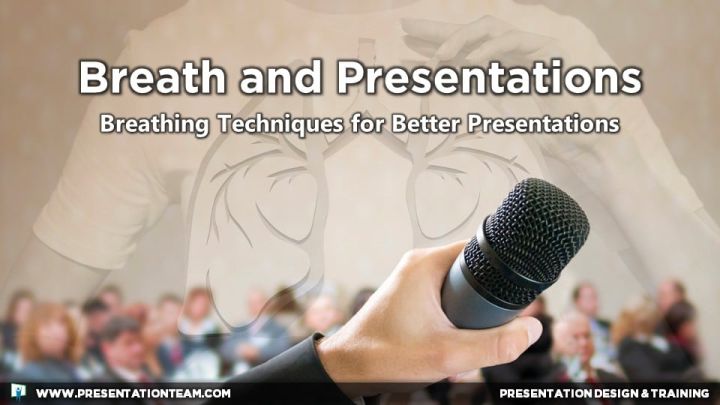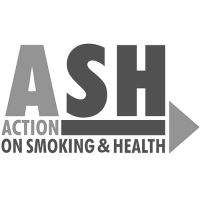Breath and Presentations: Breathing Techniques for Better Presentations

Discover how better breathing techniques can help you write, design, and deliver amazing presentations.
<Click for YouTube Video version>
When it comes to presentations, people rarely consider the importance of their breathing. Yet breathing is essential to life itself. And breathing techniques can make all the difference between adequate and amazing when preparing and delivering a presentation.
The relationship that breathing has on our mental function is subtle but straightforward. Take a few deep breaths or do some exercise, and you’ll feel sharper and think more clearly. But the opposite is also true. Sit passively at your desk, or work non-stop without a break, and your cognition and mental powers may feel dimmed.
Filling your lungs = feeding your brain
By consciously working to fill your lungs with air, you’re feeding your brain with more oxygen. More oxygen for your brain can translate to richer writing and sharper delivery. Indeed, the control and management of your breath can help you deliver a presentation with poise and professionalism.
Take a close look at today’s prominent orators- newscasters, politicians, actors. Those who are most captivating have mastered a control of their breathing to deliver a message that’s smooth and flowing.
Research proves that breathing techniques can reduce stage fright.

Do you ever find yourself right before you are going to make a big presentation; Feeling the heartbeat accelerating? Breath tension in the upper chest? Recent studies as well as ancient texts have documented how controlled breathing can decrease anxiety and insomnia, two common symptoms in people who are nervous about speaking.
In 2017 Ashwin Kamath and his colleagues at Manipal University in India studied stage fright before a public speaking engagement. The participants, all medical students, spent 15 minutes doing alternate nostril breathing. This common practice is slowly inhaling through one nostril and exhaling through the other by applying finger pressure to the side of the nose not being used. Compared with members of the control group, some participants said they experienced less stress when speaking publicly.
A message from a client…
I recently coached a woman who shared that she’s sometimes at a loss for words and sometimes makes mistakes when giving presentations. She confided that she’s been very stressed and working long hours- as many as 15 hours each day. I shared that there are plenty of tips for better content and delivery. But it was her well-being and breathing that needed the most attention. Practice and preparation are important, I explained. But treating her body and mind with some better breathing would yield far more benefits than any presentation delivery tip. She wrote me a few days later and said her better breathing has made a great difference in her presentations.
My personal revelation about breathing and presenting

For most of my life, and like most people, I used to focus on the content and basic delivery of my talks, letting my autonomic breathing perform its core function. Around mid-2018, I was teaching an advanced PowerPoint training workshop, and found myself at a loss for words several times throughout the day. I felt I just wasn’t on my game, forgetting key phrases, and stumbling my way through my program.
Then in December 2018, at age 48, I suffered a critical asthma attack. After a five-day hospital visit, my pulmonologist conducted some tests and concluded that my breathing was unusually shallow and passive. Worse, my lungs had a 16 percent lower air capacity than the average person.
It suddenly all made sense. The reason that I felt that the delivery of my speeches and training programs was getting slow and sloppy was due – in large portion – to my breathing, and poor control of it. Indeed, where once I had found it effortless to write a powerful speech delivered with poise and professionalism, I had recently been struggling to find the right words to write and deliver my speeches.
Exercise, eat well, breathe better, and present like a pro.
With 16% less oxygen filling my lungs and subsequently feeding my brain, I took action! I returned to my gym and yoga classes with a fervent focus on better breathing. I also focused on a healthier diet, eliminating all dairy and other foods that can cause mucus and respiratory inflammation. Almost instantly, I felt amplified, as the words came to my mind faster and more fluently. Writing my talks seemed easier, with a richer level of vocabulary. And my delivery seemed more professional, with a greater level of confidence, and control. Even my eyesight, aided by some carrot and ginger juice, became sharper.
Since that experience, I’ve made a point to prepare for my trainings or speeches by practicing Vinyasa yoga (or controlled pranayama breathing), eating a light dinner, and getting to bed by 10pm the night before. The morning of my program, I awaken by 6am and exercise with a focus on measured, deep breathing. When it comes time for my speech, I feel more engaged, energetic, and clear-headed. A notable improvement thanks in part to a mindful approach to better breathing.
Small adjustments in your breathing can play a big role in improving your speaking
Small adjustments in your breathing can play a big role in improving your speaking. But if you’re concerned about a more troublesome respiratory condition, or feel your breathing is restricted- or you’re wheezing or coughing- consider scheduling an appointment with a pulmonologist. This medical practitioner can analyze your lungs and provide medical treatment that can improve your airflow, translating to a healthier lifestyle.
Activate the diaphragm for calmer breathing and focused presentations

Maryam Ovissi is an alternative health practitioner, yoga instructor, and professional speaker in the Washington, DC area. In her book “Care of the Whole Self: Yoga Inspired Tools to Befriend the Self,” Ovissi explains that activating the diaphragm is a breathing practice which can cultivate calmness and aid in better presentations.
“The diaphragm is the prime muscle mover of your respiratory system. Around the diaphragm are lots of parasympathetic fibers. These are fibers that invite calmness. When you breathe and properly engage the diaphragm you are also stimulating your nervous system to get calm and centered,” explains Ovissi.
As a presentation practice, Ovissi suggests that you pay more attention to the air you take in. “Take time to inhale and exhale deeply five times before you start to speak, then take one more deep breath and breathe into your first words. Don’t forget to slow down and breathe from time to time in front of an audience.”
Basic breathing techniques help you to gain awareness and oxygenate your body

There are numerous breathing techniques that can help feed your body and mind with oxygen. For starters, try this basic breathing exercise:
- Sit forward in a chair and let your stomach muscles relax.
- Breathe in through your nose and imagine that you are a vessel filling up with air as you would pour water into a vase.
- Fill up your abdomen first.
- Then your lower ribs (you should feel them expand).
- And then all the way up to your chin.
- Hold this breath for a count of ten.
- Now exhale slowly. As you exhale, keep your ribs expanded and tighten your abdomen as you would if you were doing a “crunch”. That is, the lower abdominal muscles (keep your chest up as you exhale.)
- Repeat. Once you have mastered the exercise sitting down, practice incorporating it into your speaking and singing. Try it slowly at first until you can coordinate all the actions smoothly.
If you do the exercise correctly…
If you do the breathing exercise correctly, your stomach will go in while your chest stays out and expands. Practicing this technique will provide many benefits, including:
- Awareness of your breathing will enable you to breathe more effectively.
- Proper posture for breathing creates a confident, strong appearance. Deeper breathing makes you feel more confident and strong as well.
- Deep breathing decreases tension and helps to focus intellectual activity.
- Focused breathing can help you to deliver better presentations.
Practical breathing advice for daily life and better presentations

We take in over 20,000 breaths a day. By focusing our mind on good breathing techniques throughout the day, you will soon find yourself naturally incorporating it into your everyday speaking for better delivery with reduced stress.
Here are a few tips for practicing better breathing throughout the day:
- Practice breathing while driving. Your hands are raised as you drive which makes it easier to keep your chest high. And practicing breathing can also ease road rage significantly!
- Practice breathing while sitting at your desk when you would normally be slumped over in your chair. Sit on the edge of your chair and take ten practice breaths three times a day.
- Practice breathing when you are about to go to sleep. Or lying down on the floor at the end of a workout session.
- When you are lying down, it is easier to isolate the abdominal muscles and strengthen them for proper breathing. (You can even put a book on your abdomen. This can exaggerate the way you use those muscles for even better awareness of how to do this correctly. Watch the book go up and down as you breathe “with your stomach.”)

Thich Nhat Hanh
Tibetan Monk & Teacher
The true test will come in how well you incorporate better breathing techniques into your daily lifestyle and presentations and recognize the results. By integrating focused breathing into your mind and body, you are more likely to write better content, deliver presentations with greater ease and calmness, and remain more calm and centered.
<Click for YouTube Video version>
Similar topics:
better presentations, breath, breath and presentations, breathing, breathing practices, calmness, presentations, stage fright, yoga



























